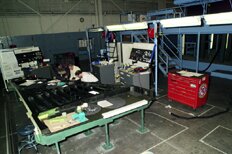|
Lean manufacturing of F-2 wing boxes
cuts waste, raises quality
Lean initiatives in F-2 production are achieving significant results at Lockheed Martin Aeronautics Co. Time reductions have become the rule, as Six Sigma audit scores climb and quality improves.
Among the variety of items that the Fort Worth plant produces for Japan’s new F-2 fighter, the most challenging is the co-cured, composite wing box. Prime contractor Mitsubishi Heavy Industries designed the wing box, and LM Aero adheres to MHI’s fabrication and assembly processes. LM Aero began delivery in March 1999 of wing boxes for F-2 production aircraft. The company will manufacture 80 percent of all left-hand wing boxes – more than 100 units – during the life of the production program, anticipated to last beyond 2010.
An F-2 Lean team was formed in Fort Worth last August. The team, with the help of lean consultants, charted a detailed course toward meeting several goals; these include reductions in man-hours and total span time, as well as higher Six Sigma audit scores and improvements in quality, safety and ergonomics.
 As a result of the team’s initial lean projects, improvements have been significant. Here are a few examples: man-hour reductions of 60 percent in painting, 50 percent in lower box trimming and a 25 percent reduction as a result of point-of-use kits and ergonomic enhancements. The distances employees travel to locate parts and equipment also have been reduced: Two stations improved by 57 percent, while another turned in an impressive 87 percent reduction. Improvements also are being noted in Six Sigma examination scores. At one F-2 station, the rating improved by 60 percent. As a result of the team’s initial lean projects, improvements have been significant. Here are a few examples: man-hour reductions of 60 percent in painting, 50 percent in lower box trimming and a 25 percent reduction as a result of point-of-use kits and ergonomic enhancements. The distances employees travel to locate parts and equipment also have been reduced: Two stations improved by 57 percent, while another turned in an impressive 87 percent reduction. Improvements also are being noted in Six Sigma examination scores. At one F-2 station, the rating improved by 60 percent.
Lean does not require that employees quicken their pace; it requires improvements in efficiency. Less waste, not haste. So the team embarked on a mission to eliminate the seven forms of waste: overproduction, idle time, excessive transportation, unnecessary processing, stock, wasted motion and defective products.
For example, detail line analysis uses videotaping of processes as a key tool to help identify waste. Like a professional football organization, the lean team videotapes each play of the game (process). They analyze the tape to determine how well the processes work compared to what is expected.
Using the tape, the team determines what changes are needed to improve product quality and build-time efficiency. In some areas, for instance, the video revealed workers spending a great deal of time collecting the right tools and equipment to perform tasks. To eliminate unnecessary travel time, point-of-use kits were created; these contain all the needed items and puts them within easy reach.
Video replays also showed how cumbersome it was for assemblers to work on the wing in a transport dolly. Thus, ergonomic improvements were implemented, leading to a new, simpler fixture and work area layout that helps to improve part quality.
Other changes also have been implemented that are contributing to impressive results. Many are still in work. The F-2 team continues to apply lean processes so LM Aero can meet its overall goals of reduced span times and improved part quality for the entire wing-box-assembly process.
Back to top
Back to Web-exclusive articles archives
|